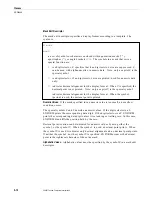
AFTER CHANGE Clause
Clauses
5–4
058057 Tandem Computers Incorporated
AFTER CHANGE
Clause
The AFTER CHANGE clause prints information preceding the records for each group
for the current report. The AFTER CHANGE clause is an optional part of a LIST
statement. The syntax of the AFTER CHANGE clause is:
AFTER CHANGE [ ON ]
by-item PRINT print-list [ CENTER ]
by-item
is the name of a field that has been grouped by a BY or BY DESC clause.
print-list
contains any combination of literals, FORM, SKIP, SPACE or TAB clauses. A
print-list can also contain the following elements that can be modified by AS, AS
DATE, or AS TIME clauses: field names, arithmetic expressions, IF/THEN/ELSE
expressions, System Variable clauses, JULIAN-DATE clauses, TIMESTAMP-DATE
clauses, TIMESTAMP-TIME clauses, user variables, or parameter names.
The clauses that can be used in a print-list are described in this section. The other
elements are described in Section 3.
The AFTER keyword of the AFTER CHANGE clause refers to the values printed, not
to the location of the printed information. For the exact location of where the AFTER
CHANGE information is printed within a report, refer to the ENFORM User’s Guide.
When more than one AFTER CHANGE clause is specified, the specified information
prints in the order in which the AFTER CHANGE clauses are entered.
Specifying a Field Name
within an AFTER CHANGE
Clause
If you specify a field name within the print-list of an AFTER CHANGE clause,
ENFORM uses the same field value as in the first row of the next group. A field name
appearing within the print-list of an AFTER CHANGE clause need not be explicitly
included within the LIST statement. If the field name is not included, ENFORM
effectively adds it with a NOPRINT clause.
Spacing Considerations
By default the AFTER CHANGE clause information begins printing in the same
column position as the leftmost report column. Using SPACE or TAB clauses as the
first element of the print-list overrides this default. SPACE or TAB clauses can also
appear anywhere within the print list. In the following example, the SPACE clauses
causes the two literals to be separated by five spaces:
AFTER CHANGE ON ordernum
PRINT "*****" SPACE 5 "Orders for " ordernum,
***** Orders for 122
Summary of Contents for ENFORM 058057
Page 6: ...New and Changed Information 058057 Tandem Computers Incorporated v...
Page 18: ...Preface xvi 058057 Tandem Computers Incorporated This page left intentionally blank...
Page 19: ...Preface 058057 Tandem Computers Incorporated xvii...
Page 269: ...Glossary Glossary 4 058057 Tandem Computers Incorporated This page left intentionally blank...
















































